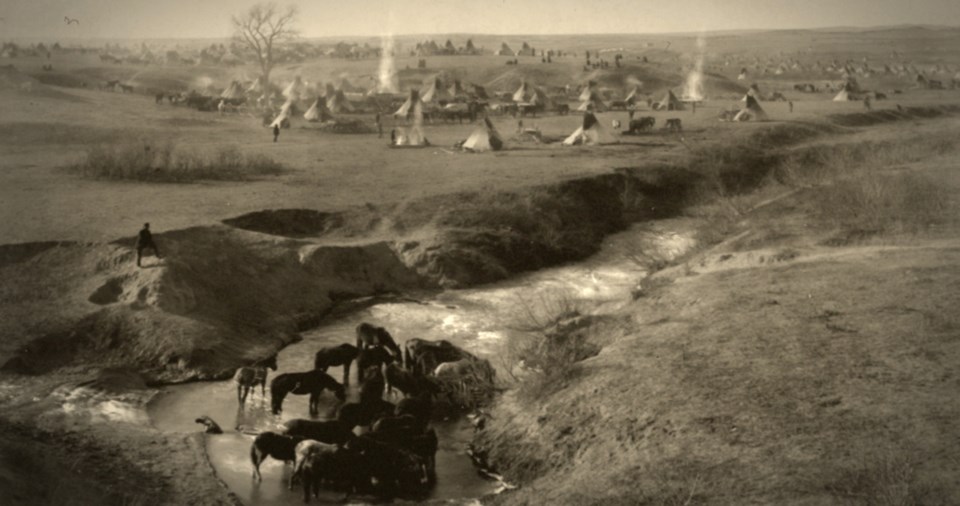Nations at War gives the full-blown epic historical documentary treatment to Canada’s First Nations battles – staggering visual effects, live-action re-enactments, soaring music, and interviews with elders, veterans and experts – but what’s most startling is that it’s never been done before.
We’ve seen this epic treatment given to the Vikings, Romans, Ancient Greeks, and big-name battles from 20th-century wars, but never to battles involving Canada’s First Nations, Inuit, and Métis – yet their battles were just as gripping and transformative as those of the Europeans, and shaped the land on which we work, play and live.
“First Nations, a lot of the times, are treated like supporting characters in their own story, as opposed to equal players,” says Nations at War series creator Tim Johnson, an industry veteran and self-described history nerd who recognized the need for this series when he tried – and failed – to find something like it on television (Nations at War will air on the Aboriginal Peoples Television Network).
“History is so complex, and there were all these big stories and interactions that had global consequences, but that people weren’t talking about,” says Johnson, who grew up in Nova Scotia and graduated from Vancouver Film School before entering the industry as a production designer. “I knew I probably couldn’t do it by myself, but I knew the history and I knew the stories and I wanted to tell them before someone else did, in all honesty.”
Johnson found an ideal collaborator in Jason Friesen, the Vancouver-based Métis filmmaker behind APTN’s comedy series Health Nutz. Friesen’s production company, Chasing Pictures, is currently developing feature dramas, factual television programming, and an animated comedy series – and Nations at War was a perfect fit.
The 13-episode series begins its narrative journey with the Haida, who once possessed one of the strongest naval forces in the Americas. Subsequent episodes introduce viewers to Louis Riel and the rebel Métis, who stunned the upstart Canadian government with a violent uprising; the Cree, facing disaster and starvation with the decline of the buffalo, making a valiant last stand to save their people's future; and the Vikings, who carved out a kingdom at the point of a sword, but whose dreams of a colony in Canada would meet a violent end.
The series is hosted by David Lyle, a familiar face to television audiences for his work on Arctic Air, Health Nutz, Arrow, and On the Farm. “He’s got that voice that commands attention,” says Johnson.
It took Johnson and Friesen nearly four years to bring the 13-episode series to the small screen – which is a relatively short timeframe when you factor in the scope and scale of what they’d set out to accomplish: more than 1,100 visual effects shots; in-depth interviews with elders and experts; gripping re-enactments that involved gruelling on-location shoots. “I’m the producer, but I’m not sitting in my office at my desk with the door closed,” says Friesen. “I’m directing. I’m on an ATV with cameras shooting buffalo herds. For me, because we were so involved on a ground level at every aspect with each episode, they all have a special place in my heart because they were all a journey in some way.”
The main challenge Johnson and Friesen faced came long before cameras rolled, when they had to decide which stories to tell. “There are a lot of other stories that haven’t been told, but you’ve got to start somewhere, and look at the wider story arc of our country and the continent itself. We tried to look at it from a bird’s eye view of, what highlights are earth-shaking? What highlights made sweeping changes? That’s not to minimize the smaller events that had more personal consequences for people on both sides of the war, but you’ve got to start somewhere. And we needed to impress people.”
One of Johnson’s discoveries from his own Nations at War journey was the far-reaching impact that First Nations battle tactics had on Canadian and British armies. “They recruited First Nations warriors, and they learned lessons of concealment, of cover, of moving, of being mobile and attacking and achieving practical goals in a very competitive battlefield. It’s all these trends and ideas from First Nations history and First Nations lifestyles filter over onto the battlefield.”
The filmmakers are appreciative of the elders who shared oral histories that simply aren’t found in books, including one of Friesen’s Métis elders, Ken Pruden. “He’s talking about the battles that our Métis people had, about out people riding with bullets in their mouths and reloading on the fly," says Friesen. "A lot of the Aboriginal tactics that were used were hunting maneuvers. When the Métis went to battle with Canadians, they were going on a buffalo hunt, and that turned into this whole thing that became guerilla warfare.”
Adds Johnson, "All of these different voices we get build a whole picture of why they fought, how they fought, what they fought with, fought like, and what the results [were], good and bad, of that violence."
• Nations at War premieres Sept. 6 on APTN. Schedule information here.


